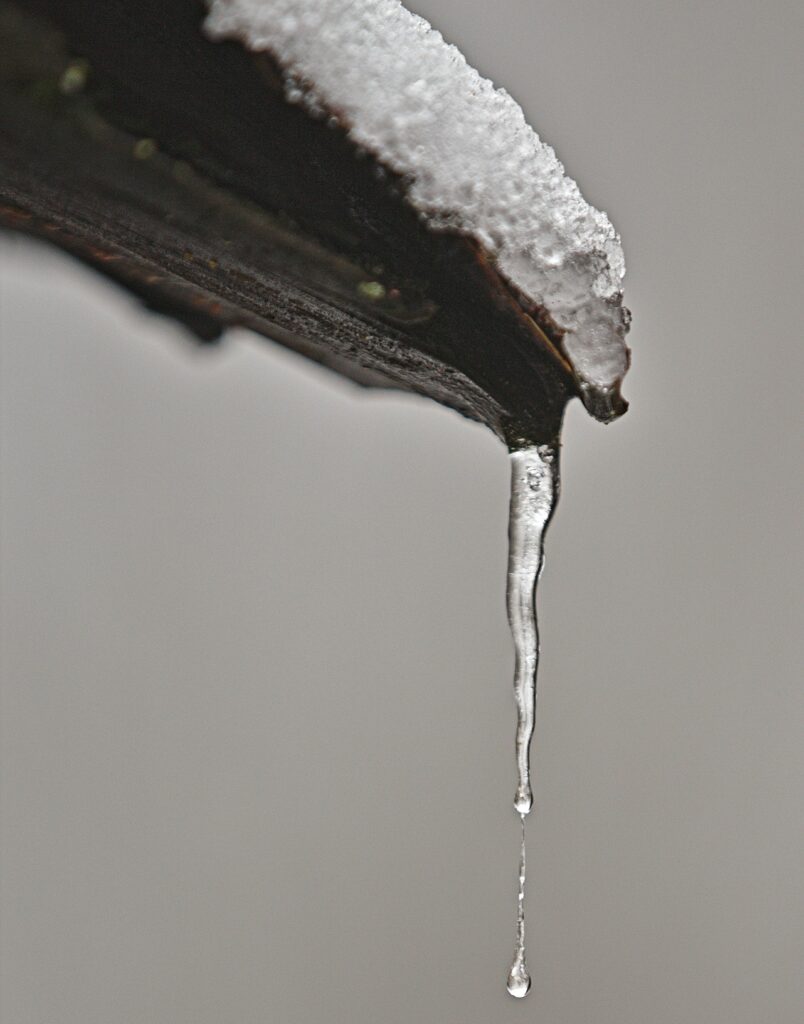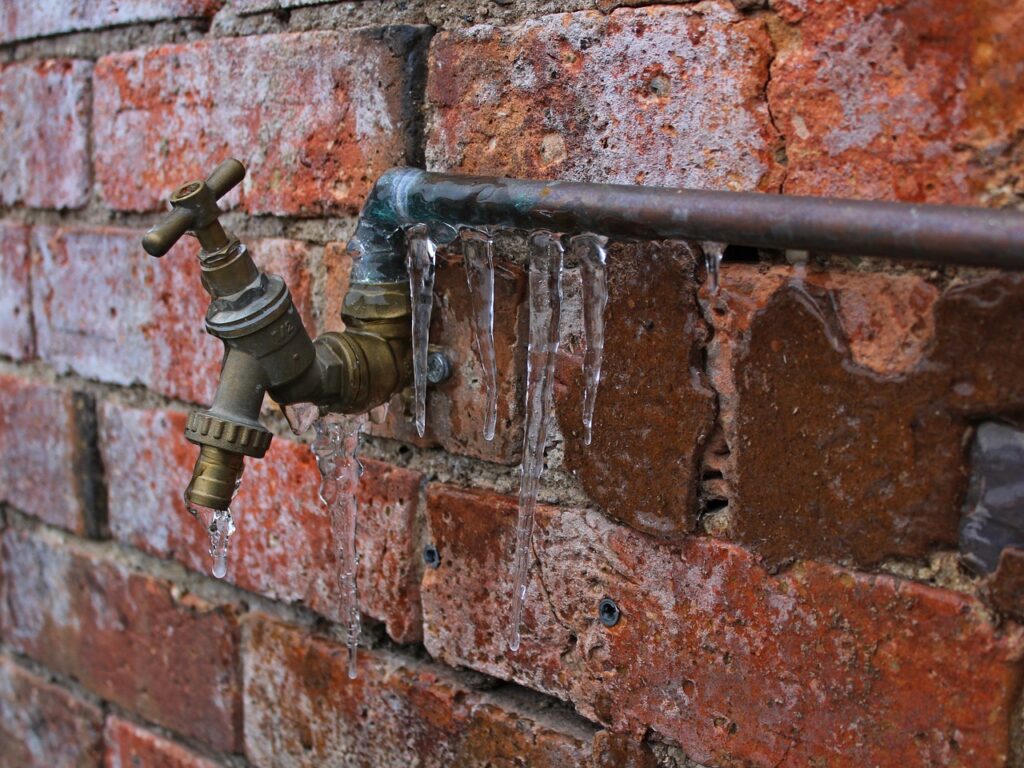In Missouri, extreme weather can threaten us year-round. Whether intense storms in the spring and summer or ice and snow in the winter, mother nature keeps us on our toes. As winter approaches, snow and ice become a common sight, posing a significant threat to the integrity of your roof and the rest of your home.
Don’t let the winter weather compromise the safety and structural stability of your property. It’s crucial to know the signs of winter roof damage, understand how snow and ice can negatively impact your home, and how to take preventive measures to minimize these risks. For a more detailed guide on roof storm damage and winter roof damage, check out our previous post!
Table of Contents
1. Winter Roof Damage From Ice
Ice dams are one of the most common winter roof damage causes. Ice dams can wreak havoc on your home, posing a serious threat caused by snow and ice. When your gutters become clogged, the snow on your roof has nowhere to escape. Instead of flowing smoothly down the gutters, the meltwater accumulates under the roof and freezes, forming a stubborn barrier known as an ice dam. Eventually, when the ice dams melt, they can lead to extensive water damage, the growth of mold, and even rot.
Fortunately, there are steps you can take to prevent ice dams from forming in the first place. To prevent roof damage, it’s crucial to clean your gutters thoroughly during the autumn season and ensure that your attic is properly insulated. By maintaining a cold attic environment, you can reduce the chances of snow melting and giving rise to ice dams. If your home is particularly susceptible to ice dams, consider installing heat cables in the autumn and using a reliable roof rake to remove any excess snow accumulation.
2. Snow Damage to Roofs and Gutters
Ice dams aren’t the only form of winter roof damage. Roof damage caused by snow is also possible. Snow is heavy, and if allowed to pile up on your roof, puts a lot of unnecessary stress on the structural framing of your roof. Even more dramatically, the extra weight can cause your gutters to completely separate from your roof, costing you in repairs and potentially causing even more damage to your roof. The weight isn’t the only issue, as large quantities of melting snow can leave your house susceptible to leaks, especially if your gutters are already clogged up.
The same steps you take to prevent ice dams apply here as well. Clean your gutters before it snows, and after, use a roof rake to remove as much as possible to relieve some of the pressure. Make sure your roof is in good condition before the winter storms hit to ensure you won’t have any leaks or more serious damage from the melting snow. Any missing shingles or damaged flashing can let water in and cause you a big headache. If you need an inspection before the winter storm hits, or have some problems that need to be fixed, we make the process easy!

3. Frozen or Burst Pipes
Everybody has a horror story about frozen pipes or a basement full of water, but with proper preparation you can avoid these problems. Your pipes can freeze if at any point they are subject to freezing temperatures for a long enough period of time. Pipes running through unheated areas such as a garage or crawlspace have the highest risk of freezing.
Frozen pipes mean no running water to anything the pipe runs to, which is bad enough on its own, but if they freeze enough, they will burst. Water expands when it freezes, so when a pipe full of water freezes, the extra volume has nowhere to go and the pipe cracks open. Not only can this lead to your house being flooded, but now you also need to repair or replace the pipe itself.
What do you do if your pipes freeze or burst? The first step is to turn off your water right away. Clean up any water that has leaked out and try to locate where the freeze of break is. Make sure your house is properly heated, and if it is a frozen pipe, you can use a space heater to try and thaw the area. After that, stock up on bottled water and wait for warmer weather.
To prevent these problems, there are several steps you can take. As winter approaches, turn off any water that goes to outside spigots if possible as these will be the first to freeze and burst. Apply heat tape and properly insulate pipes in other problem areas. Any time temperatures outside may get below freezing, keep all your faucets, both hot and cold, at a trickle. Finally, keep your heater on at least 60 degrees, even when you aren’t at home. If you are leaving town and don’t want to keep the heater running, turn off your water while you’re gone.

4. Winter Damage to Concrete
As we mentioned before, freezing water expands. If you have any crack in your driveway, foundation, or any other concrete on your property, water will get inside of them and freeze, widening the cracks. If these problems aren’t fixed, they will keep getting worse every time the water thaws and freeze again, and if these cracks are in your foundation, soon it can leak into your house.
Prevent these problems from getting worse by sealing any cracks before the winter comes. Even the smallest crack can be worsened significantly by ice, so make sure you or your contractor are thorough. It is also smart to inspect your foundation and brickwork and if needed apply sealants or tuckpointing to shore your house up against the winter.
5. Flooding
All that snow and ice has to melt eventually, and when it melts you are looking at a large quantity of water that needs somewhere to go. Make sure your gutters are clear to prevent your roof from being flooded. It would be a shame to survive without winter roof damage only to have a roof leak form from blocked gutters. Your downspout should extend at least 5 feet from your house to avert a flooded foundation, and make sure your cement and foundation are in good shape so they can handle the extra water.
6. Falling Tree Limbs
If you have trees on your property, heavy snow and ice can accumulate, and snap under the extra weight. A heavy tree limb can be one of the most severe forms of winter roof damage, but even if it misses your roof can cause damage to windows and siding. Falling debris away from your house can also cause damage to vehicles, power lines, or even injure people.
Any of these scenarios could be a nightmare, but they are easy to prevent. Simply trim any branches or limbs before the winter weather comes. Focus on any large branches within falling distance of your house, and any that are near power lines or over your driveway or walkways.
7. Frozen Garage Doors
If you have a garage door, it becoming frozen shut is a real concern. Not being able to use it is a pain and could leave your vehicle trapped inside, and in trying to open it you could damage the door or the opener. To prevent issues, when it begins to get icy, regularly open the door to keep the edges from freezing and clean away any ice or snow accumulation near the door.
If the door does get frozen shut, don’t try to pry it open or repeatedly use the opener as either of these can cause damage to the system. We recommend that you disengage the opener, clean away all the snow and ice however you can, and try to open the door by hand. Once you can open the door by hand, it is safe to reengage the opener and use the door normally.
Conclusion
Whether you are looking for ways to prevent roof damage, or prevent damage to the rest of your home, there are several things you can do to that will help. Make sure your attic is properly insulated to prevent ice dams from forming. Clean your gutters before the winter storms come to help with snow and ice buildup and to prevent leaking and flooding.
Seal any cracks in your cement and foundation to keep them from getting worse and make sure downspouts are functioning and drain at least 5 feet from your house to prevent your basement from flooding. Keep your house warm and taps running during freezing weather to keep your pipes from freezing. Finally, trim any dangerously place tree limbs, and if your garage door freezes, make sure you don’t break it trying to get it open.
If you think your roof is damaged, find out what steps to take here.
If you need an inspection, repairs, or just have a question, reach out to us and we can help you out!